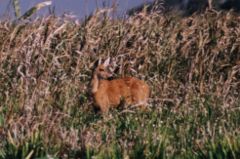
Ozotoceros bezoarticus
Ozotoceros bezoarticus NatureServe Explorer Species Reports — NatureServe Explorer is a source for authoritative conservation information on more than 50,000 plants, animals and ecological communtities of the U.S and Canada. NatureServe Explorer provides in-depth information on rare and endangered species, but includes common plants and animals too. NatureServe Explorer is a product of NatureServe in collaboration with the Natural Heritage Network. It is medium-sized, lightly built cervid. Head and body length is 110 – 140 cm, shoulder height is 70 – 75 cm. The prevailing color of the upper parts and limbs is reddish
ITIS Reports — Ozotoceros bezoarticus ITIS (the Integrated Taxonomic Information System) is a source for authoritative taxonomic information on plants, animals, fungi, and microbes of North America and the world.
FWS Digital Media Library — The U.S. Fish and Wildlife Service’s National Digital Library is a searchable collection of selected images, historical artifacts, audio clips, publications, and video. The Pampas deer is a species of deer that live in the grasslands of South America at low elevations. They are known as venado or gama in Spanish and as veado-campeiro in Portuguese. Their habitat includes water and hills, often with winter drought, and grass that is high enough to cover a standing deer. Many of them live on the Pantanal wetlands, where there are ongoing conservation efforts, and other areas
| Status | Date Listed | Lead Region | Where Listed |
|---|---|---|---|
| Endangered | 06/14/1976 | Foreign (Headquarters) | Wherever found |
- Countries in which the the Pampas deer, Wherever found is known to occur: Argentina, Bolivia, Brazil, Paraguay, Uruguay
| 06/14/1976 | 41 FR 24062 24067 | Endangered Status for 159 Taxa of Animals; 41 FR 24062 24067 |
| 09/26/1975 | 40 FR 44392 44333 | CITES: Proposed Endangered Status for 216 Species on Convention Appendix I; 40 FR 44392 44333 |












